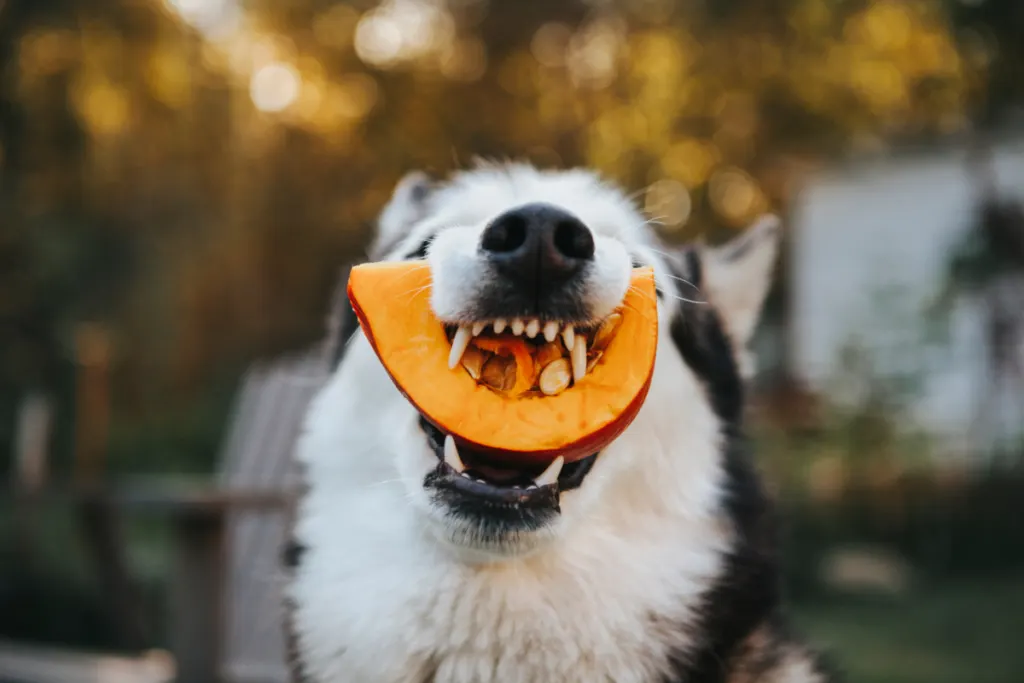Pumpkin is not only a popular food choice for humans, but it can also be a healthy addition to your dog’s diet. In this article, we will explore the nutritional benefits of pumpkin for dogs and provide guidelines for serving it safely.
Before we proceed any further, it is highly important to pay attention to the following instruction:
DO NOT FEED YOUR DOG PUMPKIN PIE MIX!
It looks similar to canned pumpkin, but it’s filled with sugars and other ingredients that you do NOT want to give to your dog!

Click Here to Jump to a Section
Nutritional Benefits:
Pumpkin is packed with essential vitamins, minerals, fiber, and antioxidants that offer numerous health benefits for dogs. It supports digestive health, promotes a healthy skin and coat, and contributes to overall wellness.
Vitamins and Minerals:
Pumpkin is rich in Vitamin A, which aids in maintaining good eye health in dogs. It also contains vitamins B6, C, E, and K, along with minerals like iron, magnesium, and potassium. These nutrients strengthen the immune system and provide energy.
Fiber Content:
With its high fiber content, pumpkin helps regulate digestion by adding bulk to stools. This can prevent issues such as constipation or diarrhea. Additionally, the fiber in pumpkin aids in controlling blood sugar levels, making it beneficial for diabetic dogs.
Serving Suggestions:
When serving pumpkin to dogs, consider the form, amount, and individual needs of your pet.
Fresh or Canned Pumpkin?
Fresh pumpkin, cooked and mashed, provides more nutrients compared to canned pumpkin, which may contain preservatives. However, both options are suitable, as long as canned pumpkin is plain with no added sugars or spices.
How Much To Feed?
The amount of pumpkin depends on your dog’s size and activity level. Generally, small breeds can have around 1 teaspoon per day, while larger breeds may require up to 2 tablespoons. It’s important not to exceed these amounts to avoid digestive issues.
What Form To Feed?
Pumpkin can be served cooked or raw, depending on your dog’s diet plan. For example, mashed cooked pumpkin can be added to wet food. Commercially available dehydrated treats with dried pumpkin pieces are also convenient options.
Potential Risks:
While pumpkin is generally safe for dogs, consider the following risks:
Allergies and Intolerances
Like humans, dogs can develop allergies or intolerances to pumpkin. If your dog experiences symptoms such as itching, redness, hives, sneezing, coughing, or vomiting, discontinue feeding pumpkin and consult a veterinarian.
Interactions with Medications and Supplements
High fiber content in pumpkin can interfere with the absorption of certain medications or supplements. Consult your vet if your dog is taking any medication or supplements before introducing pumpkin to their diet.
Additional Considerations:
Factors such as age, breed, and special dietary needs should be considered when feeding pumpkin to dogs. Puppies may require smaller portions, while senior dogs may have different requirements based on their health and activity level. Consult a veterinarian for personalized advice.

FAQs:
- How much pumpkin can I give my dog? The amount depends on the dog’s size and activity level, with small dogs typically needing one teaspoon and larger dogs up to one tablespoon per day.
- Is pumpkin toxic to dogs? No, pumpkin is not toxic to dogs. However, moderation is key to avoid digestive issues.
- Can I feed raw pumpkin to my dog? Yes, raw pumpkin is safe for dogs. Ensure the pieces are small enough for them to eat comfortably and avoid adding harmful ingredients.
- What part of the pumpkin can dogs eat? Dogs can safely eat the fleshy inside and seeds of the pumpkin. Avoid feeding them the skin, as it may be difficult to digest.
Remember to consult with your veterinarian before introducing any new food into your dog’s diet, especially if they have allergies, medical conditions, or are taking medications.
